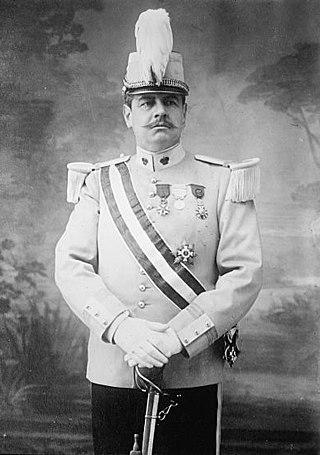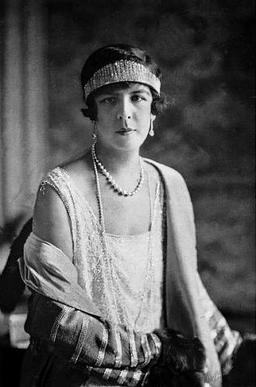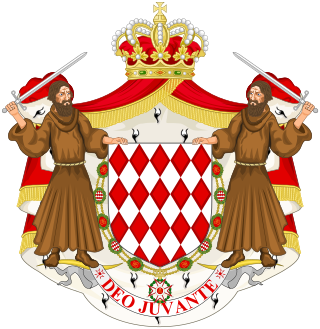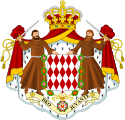
Morganatic marriage, sometimes called a left-handed marriage, is a marriage between people of unequal social rank, which in the context of royalty or other inherited title prevents the principal's position or privileges being passed to the spouse, or any children born of the marriage. The concept is most prevalent in German-speaking territories and countries most influenced by the customs of the German-speaking realms.
Primogeniture ( ) is the right, by law or custom, of the firstborn legitimate child to inherit the parent's entire or main estate in preference to shared inheritance among all or some children, any illegitimate child or any collateral relative. In most contexts, it means the inheritance of the firstborn son ; it can also mean by the firstborn daughter.

Louis II was Prince of Monaco from 26 June 1922 to 9 May 1949.

Princess Charlotte, Duchess of Valentinois, was the daughter of Louis II, Prince of Monaco, and the mother of Prince Rainier III. From 1922 until 1944, she was the Hereditary Princess of Monaco, heiress presumptive to the throne.

Princess Antoinette, Baroness of Massy was a member of the princely family of Monaco. She was the elder sister of Prince Rainier III. Her parents were Count Pierre de Polignac and Charlotte, Hereditary Princess of Monaco and Duchess of Valentinois.
An heir presumptive is the person entitled to inherit a throne, peerage, or other hereditary honour, but whose position can be displaced by the birth of a person with a better claim to the position in question. This is in contrast to heirs apparent, whose claim on the position cannot be displaced in this manner.

Princess Caroline of Monaco is, by her marriage to Prince Ernst August, the Princess of Hanover. As the eldest child of Rainier III, Prince of Monaco, and Grace Kelly, she is the elder sister of Albert II, Prince of Monaco, and Princess Stéphanie.

The succession to the throne of the Principality of Monaco is currently governed by Princely Law 1.249 of 2 April 2002.

Succession to the British throne is determined by descent, gender, legitimacy, and religion. Under common law, the Crown is inherited by a sovereign's children or by a childless sovereign's nearest collateral line. The Bill of Rights 1689 and the Act of Settlement 1701 restrict succession to the throne to the legitimate Protestant descendants of Sophia of Hanover who are in "communion with the Church of England". Spouses of Catholics were disqualified from 1689 until the law was amended in 2015. Protestant descendants of those excluded for being Roman Catholics are eligible.

The House of Grimaldi is the current reigning house of the Principality of Monaco. The house was founded in 1160 by Grimaldo Canella in Genoa and became the ruling house of Monaco when Francesco Grimaldi captured Monaco in 1297. The House of Grimaldi has produced every Prince of Monaco. During much of the Ancien Régime, the family resided in the French court, where from 1642 to 1715 they used the title of Duke of Valentinois.

The sovereign prince is the monarch and head of state of the Principality of Monaco. All reigning princes have taken the name of the House of Grimaldi, although some have belonged to other families in the male line. When Prince Rainier III died in 2005, he was Europe's longest reigning monarch. The Grimaldi family, which has ruled Monaco for eight centuries, is Europe's longest-ruling royal family.
The Franco-Monégasque Treaties of 1861, 1918, and 2002 are the basis of the relationship between the French Republic and the Principality of Monaco. The treaties define Monaco's independent status and sovereignty, as well as the rights of succession of the princely House of Grimaldi.
The Monaco succession crisis of 1918 arose because France objected to the prospect of a German national inheriting the throne of the Principality of Monaco. Prince Albert I had only one legitimate child, the Hereditary Prince Louis, then heir apparent to the principality. As World War I drew to a close, Prince Louis, at the age of forty-eight, remained (legally) childless, unmarried, and unbetrothed.
Jazmin Grace Grimaldi is an American actress and singer. She is the daughter of Prince Albert II of Monaco and Tamara Rotolo.
Since 2011, the crown of Luxembourg descends according to absolute primogeniture among Grand Duke Henri's descendants and according to agnatic primogeniture among other dynasts.
An order of succession or right of succession is the line of individuals necessitated to hold a high office when it becomes vacated, such as head of state or an honour such as a title of nobility. This sequence may be regulated through descent or by statute.

The Prince's Palace of Monaco is the official residence of the Sovereign Prince of Monaco. Built in 1191 as a Genoese fortress, during its long and often dramatic history it has been bombarded and besieged by many foreign powers. Since the end of the 13th century, it has been the stronghold and home of the Grimaldi family who first captured it in 1297. The Grimaldi ruled the area first as feudal lords, and from the 17th century as sovereign princes, but their power was often derived from fragile agreements with their larger and stronger neighbours.
Baron Christian Louis de Massy is the son of Princess Antoinette of Monaco, Baroness de Massy, and her husband, international tennis champion Alexandre-Athenase Noghès. His grandfather, Antony Noghès, created the world-famous Monaco Grand Prix. He was one of the two page boys at the wedding of his uncle Rainier III with Grace Kelly.

The monarchy of Denmark is a constitutional institution and a historic office of the Kingdom of Denmark. The Kingdom includes Denmark proper and the autonomous territories of the Faroe Islands and Greenland. The Kingdom of Denmark was already consolidated in the 8th century, whose rulers are consistently referred to in Frankish sources as "kings". Under the rule of King Gudfred in 804 the Kingdom may have included all the major provinces of medieval Denmark.

Claudine or Claudia was Lady regnant of Monaco between 1457 and 1458, and the Lady consort of Monaco by marriage to Lord Lambert of Monaco.










